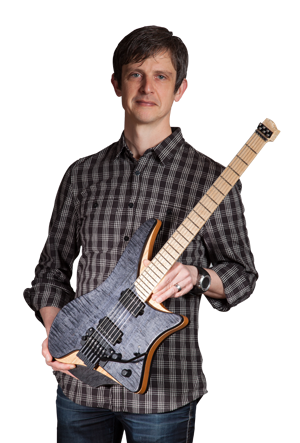Some progress on #5 and #6 – did final shaping of body side contours and fretboards, slotted fretboards and assembled the custom hardware for...
Learn MorePress the “Play” button and then move your pointer to “More” and choose “Auto Play” in the menu that appears. Click the navigation buttons at any time to navigate manually. Enjoy! The Ergonomic Guitar System on...
Learn MoreMany players have contacted me and been curious about how the EGS guitars sound with “normal” pickups. Johan Lundgren of Lundgren Guitar Pickups kindly lent me a pair of Heaven ’57 humbuckers for a test. Getting this done was not as straight-forward as I had hoped. The Alumitones are a few millimeters smaller (36 x 65 mm) than a regular humbucker (38 x 68 mm), and for aesthetical purposes I had cut the pickup cavities as close to the original Alumitones as possible. This meant that I actually had to get the router out to enlarge the holes for the test. Another interesting fact is that the two Lundgren pickups weigh 250 grams and the two Lace pickups weigh 90 grams. With the EGS#1 guitar weighing in at about 2kg, it still results in a fairly light instrument, but the increase in weight is quite large percentage-wise. You will have to judge the results for yourself. The larger frequency response of the Lace pickups allow them to be equalized into any type of sound using tone controls and effects, but the clips are recorded with the same settings on the amp. Some comments from Jonas – his personal views and reflections: The Alumitones have a “sparkle” on the high...
Learn MoreIt is long overdue, but here are a couple of initial tests of mounting piezo transducers in the EGS bridges. I mentioned this already in the beginning of the year after having received samples from GraphTech. All in all, adapting the tuners to using piezos was very simple. And, for use with the tremolo where individual string height adjustment, the case is closed here. However, when mounting the bridges individually with the fixed version of the bridge, it is necessary to be able to adjust the height of each string. Most likely, I will have to solve this using one or two set screws accessible at an angle from the front of the tuner to adjust height. This means having to release tension from the string in order to adjust height (since it uses the same screw for fastening and adjusting intonation). Some work remains. Also, it remains to find a routing of the cables. This is easier with the upper version (IceTone) that has the cable coming out towards the rear. The regular ghost saddle on the bottom has the cable coming out through the bottom and requires some clearance to be created for it. Here are some more pictures. Please let me know which is preferrable or...
Learn MoreI have finally decided what to make of #6. As I am building it along with #5 (custom order by Chris Letchford), I will make this also a fanned fret 7-string, 25.75 – 25″ scales. But, it will have a trapezoidal neck profile (contact Rick Toone for more information about this neck profile) and the cavities in the body will be made differently. #5 will have cavities routed from above and a top glued onto it like my other EGS guitars. #6 will have cavities routed from the inside edges of the sides. I have never tried this in practice, so it somewhat of an experiment. Here is the neck blank along with the sides for #5 roughly cut: And the future #6: Some routing templates for these and future neck-through builds. A swatch for #5 of: rosewood fretboard (that looked a little too purple at first, but better when oiled), wenge for the top, mahogany for the back, maple for the neck blank, custom colored blue hardware and Lundgren M7 pickups. Last but not least, Chris has requested position markers placed off-center, so here is a...
Learn MoreI have had a new tuner in the works for some time. The spark was the electric tri-kanta that I am collaborating with luthier Michele Benincaso on. We met again yesterday to discuss it and a new improved version of the string anchors described here. The key points for the design are: compact mounting, low weight (there will be 36 of them on the tri-kanta), durability, cohesion with the current EGS designs and, last but not least, it should be able to retro-fit into existing instruments to improve ergonomics. Here are some pictures of the first prototype: As you can see, it fits into a standard tuner hole. The difference here is that the tuner extends behind the headstock and does not rely on being mounted close to an edge. Additionally, with the low profile, the angle over the nut will be higher possibly eliminating the need for string trees or the use of an angled headstock. It uses the same parts as the current EGS bridges, so the investment in developing them can be leveraged. The design issue that we discussed yesterday was how to tighten the assembly into the headstock. We do not want any risk of scratching the surface of the headstock in case of having...
Learn More


